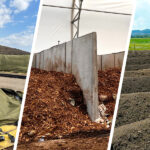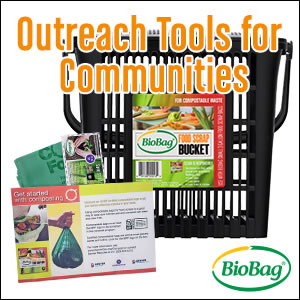
Sally Brown
BioCycle August 2015
Did you realize that 43 states now have waste diversion goals? That is pretty impressive. Waste diversion goals are not nearly as common as Starbucks stores. But I would bet that every state that has a waste diversion goal also has more than a few Starbucks stores. And I would also bet that the Starbucks stores reach a high percentage of the population within each one of those states. I have not traditionally been a big fan of Starbucks. But with the Flat White coffee option and those breakfast sandwiches, you could say that I’m a convert. Turns out that other people are too. Starbucks just had an amazing last quarter, with sales up 7 percent due to an increase in customer traffic. You may not see the connection between the two, but work with me here.
I stopped at a Starbucks in the airport on my way to visit friends in Gainesville, Florida. Florida is one of those states with a waste diversion goal. Based on my week in a traditionally liberal, environmentally aware university town, Florida hasn’t got a clue of how to get there. Talking about Starbucks could help them. Earlier this year in Portland, Oregon, a town with many coffee options that is also well on the way to meeting its waste diversion goals, I gave a talk about Starbucks at the BioCycle West Coast Conference. My task for the presentation was to show how you can use back of the envelope calculations to communicate the importance and impact of small steps to divert waste and to build climate resiliency. I opted to use the Starbucks example as the Northwest is known for its coffee.
Starbucks is just one example of taking something that very many people are familiar with and showing how small changes in their behavior can have a big impact — including meeting waste diversion goals. People want tools. This is a very easy one to give them. So let’s get down to the grinds.
Doing The Math
Does it really matter if the people at Starbucks recycle the coffee grinds? Before I read about the 7 percent increase in sales, I figured that a conservative estimate puts the number of coffees served at each store at about 300 per day. To be accurate with my estimate, I dutifully weighed the grounds from my home brewed latte and got 30 grams as the approximate weight. Thirty grams is the same as 0.03 kilograms. So if each store serves 300 cups of coffee per day that is:
0.03 kg grinds per cup of coffee x 300 cups of coffee per day or 9 kilograms (kg) of grinds per store per day
Heavy to lift, but nothing excessive you may say. But Starbucks are open all year long. So let’s express that on an annual basis instead of on a daily basis:
9 kg per store per day x 365 days per year equals 3, 285 kg per year
Converted to tons, that comes out to about 3.3 tons of coffee grinds per store per year. You are no longer talking about heavy to lift. You are talking about needing equipment to lift.
I read on line that Starbucks has 20,000 stores worldwide. That may be an old number but it is good enough for these calculations. So if one store makes 3.3 tons of coffee grinds, how much do all 20,000 stores make each year?
3.3 tons of grinds per store per year x 20,000 stores worldwide equals 66,000 tons of grinds
That is not a small amount. What is the value of taking all of those grounds and putting them to a higher and better use, e.g., in your home garden? Well it turns out that coffee grounds are actually pretty nutrient rich. They have a decent amount of each of the big three plant nutrients, nitrogen (N), phosphorus (P) and potassium (K). They are richest in N, which is also the nutrient that the plants need the greatest amount of. Each kilogram of grounds is about 2.3% N. That means that for each ton of grounds (1000 kg) you get:
1000 kg x 0.023 (%N) equals 23 kg nitrogen
Consider how many grounds the chain produces world wide on an annual basis:
66,000 tons of grounds x 23 kg N per ton = 1.52 million kg of nitrogen
But what does that mean in terms of growing food? A typical fertilization rate (and also one that gives a nice round number) is 100 kg of N per hectare. To figure out how many acres of land could be fertilized with those coffee grinds, divide 1.52 million total kg of N by 100 kg of N per hectare to get the number of hectares of land. It comes out to about 15,200 hectares of land.
Circling Back To Flat White
Let’s bring this back to that flat white I like so much. The flat white has a lot of milk. The cows that make the milk eat about 14 kg of hay a day (about 5 tons/year). It takes about 2 hectares of land to make 5 tons of hay (in the United Kingdom, a good place to grow grass).
15,200 hectares of land fertilized by Starbucks coffee grounds/2 hectares of land per cow = 3,000 cows
So the 15,200 hectares of fertilized hay can feed about 3 000 cows. Each cow makes about 10 000 kgs of milk annually. That comes to 30.4 tons of milk. If you figure that each flat white has about 250 grams of milk, that means that enough hay has been fertilized to feed enough cows to make 80,000 flat white coffees each year.
Granted, this is not enough to produce all of the milk that Starbucks uses, but it would certainly make a dent. And more than making a dent in Starbucks’ milk demand, it makes a point about how you can make a difference. All of those people that have the Starbucks app on their phone (about 20% of the U.S. customers) and even those who pay by cash or credit card would get this calculation. It is just one of the many tools that those 43 states including Florida can use to meet their waste diversion goals, not to mention contributing to building climate resiliency.
Sally Brown is a Research Associate Professor at the University of Washington in Seattle and a member of BioCycle’s Editorial Board.












